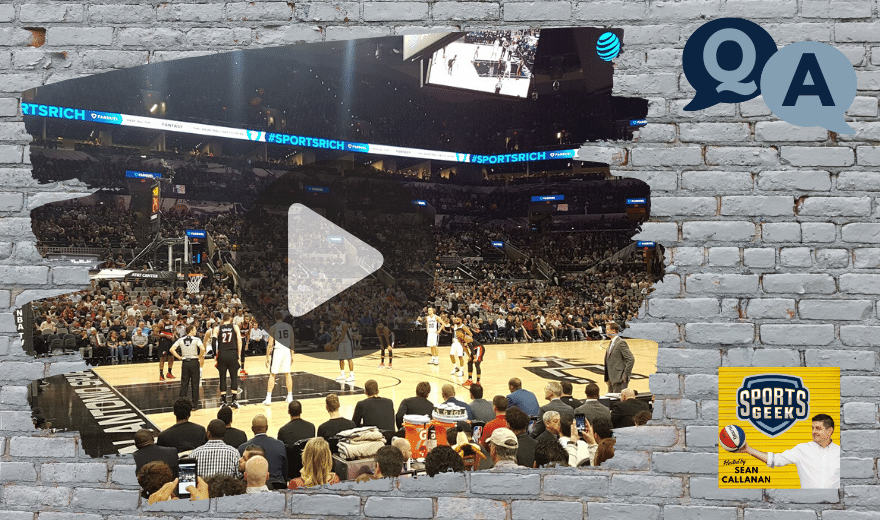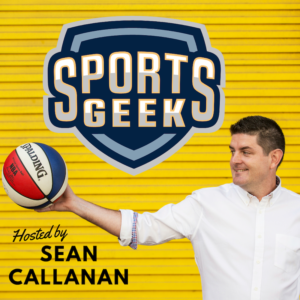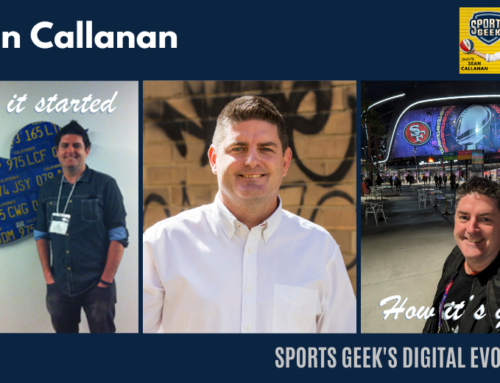On episode #10 of Sports Geek Q&A episode Sean Callanan answers the following questions from Paul Roach:
- What is the difference between streaming and OTT are they the same thing?
- How are streaming/OTT offerings disrupting broadcast business model?
- How will we be consuming sports in 5 years time?
Listen to Sports Geek Q&A for the answers
Can't see podcast player? Click here to listen
Read Sports Geek Q&A answers below
Transcriptions done by robots in Descript app (they are getting better but not yet perfect)
So I decided to take the three best ones and put them into one episode. So they very much, Paul, I hope my answers help you in the paper that you're writing. I look forward to, right. reading it down the track wants these done. but Paul had some questions. And the first one was, what is the difference between streaming and OTT?
Are they the same thing? or not. And so my answer, my definition, streaming and to me, streaming and OTT are different. OTT if you don't know, it stands for over the top. and building an over the top service that sits on a platform like Apple or Google play and those kinds of things. So when we think of OTT and Netflix is OTT.
Hulu is OTT. NBA league pass. MLB At Bat is their own own OTT. So you're building something that's yours, and pushing content through. Whereas when someone says streaming, I think of, streaming something that is streaming on a service. So a YouTube offers a streaming service. Obviously Facebook art, the Facebook officer's streaming service, is a famous.
Streaming service in the, in the gaming space. so that's how I differentiate, differentiate it. they are used relatively, interchangeably. but what we are seeing is more and more, publishers, especially from a traditional saints building out their own OTT. Offerings, to mitigate the risks of, fragmented markets and things like that.
So that's how, that's my definition. OTT is when you build something yourself, it might be on a mobile phone. It might be sitting on a platform like Apple TV. whereas streaming is. Oh, yes, we've got to put our content on that streaming platform. and that's where, you know, YouTube, and Twitch and Facebook and, and to a certain extent, Amazon, sort of come into, come into play and that's where you can stream.
Transcriptions done by robots in Descript app (they are getting better but not yet perfect)
That's a question Two, was really around the, the crux of Paul's paper was around how streaming and OTT offerings of disrupting the broadcast model in sports. I guess my first take on this is that, the technology is still, I think the technology is far out paced, the lawyers, so the broadcast agreements that that, sports rights holders have had, Have been caught being caught out, especially in the last 10 years, had been caught out by the internet. in what, the, the rights that someone might have if they had, you know, in some instances it was internet rights, which meant everything, which was a very broad scope. And now slowly digital rights and streaming rights have been carved off and been more defined by the lawyers.
So I think that's the, that's the first thing. Okay. And then the other, the other part of it is the changing. changing behavior, these different players in these markets that only want the streaming component. So whereas the media rights used to be, he's the biggest bundle. It's going to the broadcast.
it's going to the broadcaster, you know, a free to air broadcaster and that would take everything. And digital was really the, the top up number. the streaming was the top number. but what we are seeing is the, is the shift of, of viewership. and so we've, we've seen a lot of, courting of, of platforms like Facebook and Amazon and, and Twitter to try and get them into the same conversation of buying the rights and buying live rights and access to, to, to live sport as a way to, get eyeballs and advertising and those kinds of things. and so that has caused disruption. but at the moment. Those players, haven't yet put down the cold hard cash for a lot of those games.
So we're really in an interesting space right now, from a rights holder point of view and from a broadcast point of view of what do the next round of rights look like. you know, and so that's why you've seen varying lengths of, of broadcast deals being done, some pushing them longer. to give them some maturity and some stability.
I think the next, 12 to 18 months to three years are going to be really interesting to see, where sports and, and traditional broadcast is land. And also where those streaming rights end up. Do they end up staying with the sports rights holder to the broadcast to take them, will a third party take them and try to monetize them?
I think that's going to be something that's really interesting to watch. And also where that, where that revenue comes in, and who are the winners out of it. from a sports side of thing, I hope the hope the sports still gets its money because it is very much foundational to the, to the, to the whole business model, business model of sport. If the advertisers, don't pay or the TV broadcast and getting the advertising revenue, then that's obviously gonna affect the, the, the number, that they go for.
Transcriptions done by robots in Descript app (they are getting better but not yet perfect)
The third question, or one of the, one of the questions, and the third question I'm going to use in this instance from Paul was, how will we be consuming sports, in five years time?
Putting on, you know, a futurist goggles, or trying to look too far in the future is sometimes dangerous. especially if we look back, or what the landscape looks like. Say, 10 years ago when I started sportsgeek, there wasn't a lot of streaming offerings, in the sports space. MLB at bat was one of the premium ones at that point.
We fast forward 10 years in MLB at bat. Became BAM tech, and then eventually bought by Disney. That technology of watching baseball was all is now embedded into Disney+. so, but I do think one of the changes that has happened and especially in the last five years, and it just keeps, seem to accelerate, keeps, accelerating is that more on demand and more. Fragmentation and more selection of specific supports will be what is available and what is also expected of consumers. I think if talked to a 10 year old right now and they're there, they're going to be the next subscribers in 10 years time.
They don't go to a TV screen first. they expect to be able to pull up their phone and hit a button and watch something. because that's how they've grown up with Netflix and YouTube and the like. Appointment viewing and those kinds of things, or even reaching for a TV remote is potentially already foreign to them.
So I'll say more OTT. Going back to the original first question, we'll see more OTT offerings of leagues and sports offering an app or something on the Apple TV that allows you to access the games, whether it is playback, a replay type, but also live. So that will happen. And so I think your pick your, your sports, you'll say, yes, I'm an NBA fan, I'll have League Pass.
I want to watch the EPL or I'll get something for, for premier league. and how it gets delivered in our region will be the piece. so what was happening bundling in, in cable form. You know, five or 10 years ago will now be happening, in these OTT services, potentially, there might be some bundling.
We've already seen that with Disney plus bundling, Disney, Hulu, and ESPN. so we might see those big giants do that, but that will be the challenge for marketers and sports and sports rights holders in the future. you won't have this cross promotion of, of big. mainstream TV or, or cable operators.
If people are just picking, I just want to follow my team, or I just want to follow the league. and it'll put more stress on that, that snackable content to draw people in and see if they will then draw into and be drawn into the full games. that'll be the, I think that'll be the big thing. you know, will we be watching full game start to finish?
What will the model look like for us to do these tune in red zone style with the NFL, more these 99 cents. I want to watch the last five minutes of the game in the NBA that these is toyed with. I think they're, they're some of the things that will be different hopefully. By then we'll fix the micro payment, and make that, make that rather frictionless.
If that becomes frictionless, then I think it will be far easier for us, for, for the consumer.
Pick my brain
Want some help on a campaign, sponsorship or content but don’t know where to start? Book a time with Sean Callanan for a Pick My Brain session.
The Pick my brain session is a two-hour video consulting session where you can get Sean’s thoughts and opinions on ticketing or sponsorship campaigns, campaign development and digital content review.











